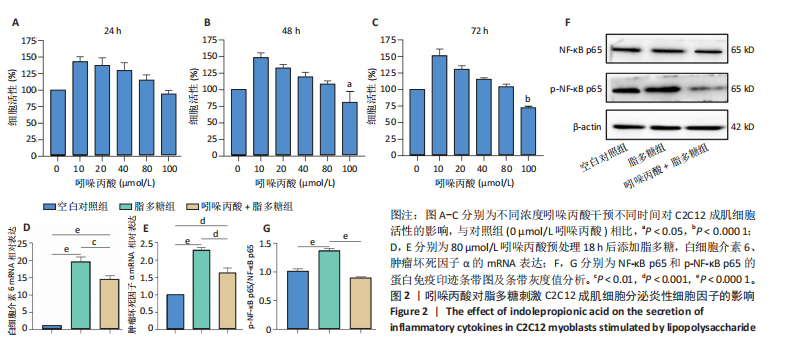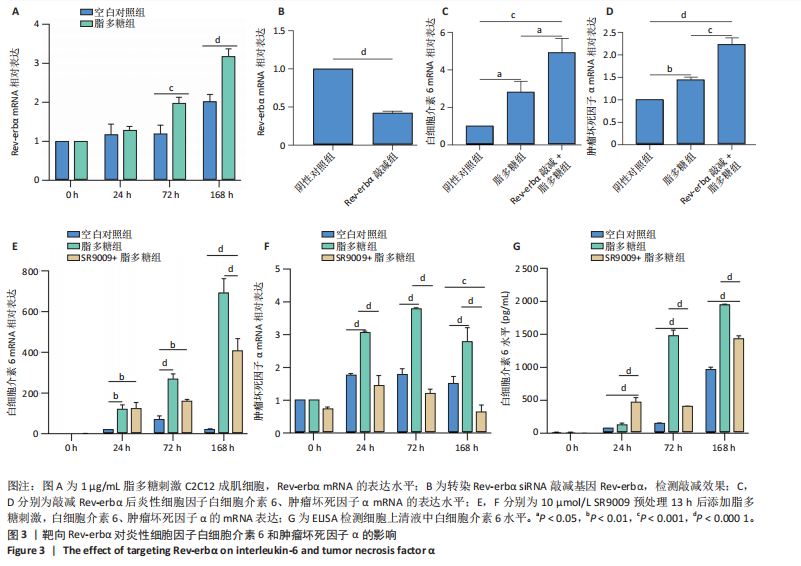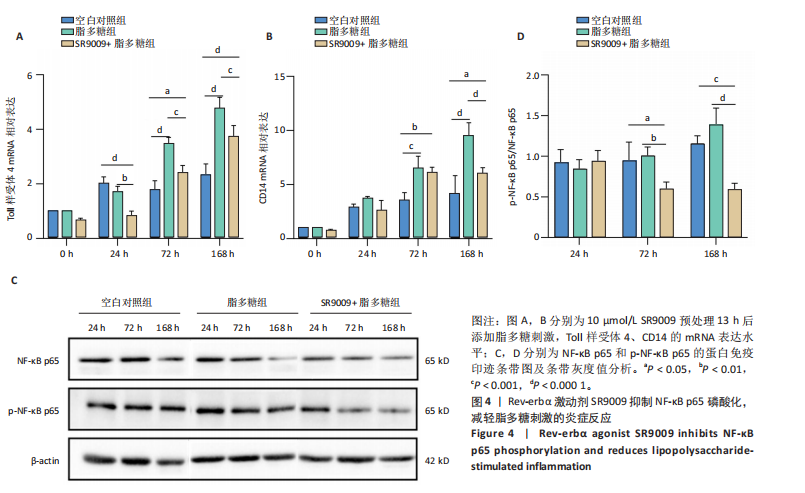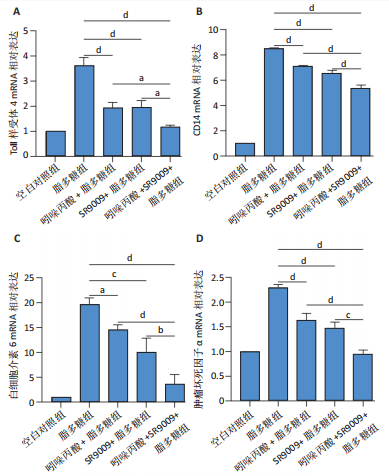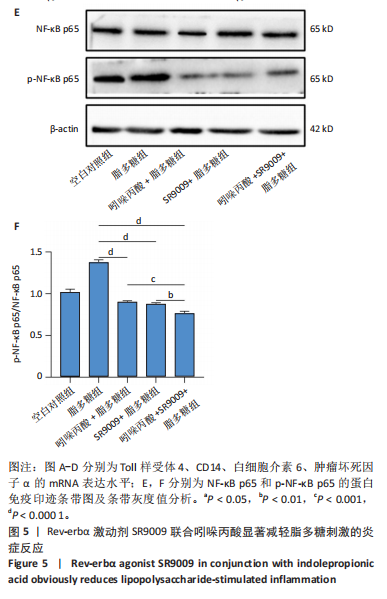[1] ZHANG-SUN ZY, XU XZ, ESCAMES G, et al. Targeting NR1D1 in organ injury: challenges and prospects. Mil Med Res. 2023;10(1):62.
[2] MAYEUF-LOUCHART A, THOREL Q, DELHAYE S, et al. Rev-erb-α regulates atrophy-related genes to control skeletal muscle mass. Sci Rep. 2017;7(1):14383.
[3] RAZA GS, SODUM N, KAYA Y, et al. Role of Circadian Transcription Factor Rev-Erb in Metabolism and Tissue Fibrosis. Int J Mol Sci. 2022; 23(21):12954.
[4] WANG J, LIU Z, XU Y, et al. Enterobacterial LPS-inducible LINC00152 is regulated by histone lactylation and promotes cancer cells invasion and migration. Front Cell Infect Microbiol. 2022;12:913815.
[5] AFROZ R, TANVIR EM, TANIA M, et al. LPS/TLR4 Pathways in Breast Cancer: Insights into Cell Signalling. Curr Med Chem. 2022;29(13): 2274-2289.
[6] SINGER-ENGLAR T, BARLOW G, MATHUR R. Obesity, diabetes, and the gut microbiome: an updated review. Expert Rev Gastroenterol Hepatol. 2019;13(1):3-15.
[7] ONO Y, SAKAMOTO K. Lipopolysaccharide inhibits myogenic differentiation of C2C12 myoblasts through the Toll-like receptor 4-nuclear factor-κB signaling pathway and myoblast-derived tumor necrosis factor-α. PLoS One. 2017;12(7):e0182040.
[8] YU D, FANG X, XU Y, et al. Rev-erbα can regulate the NF-κB/NALP3 pathway to modulate lipopolysaccharide-induced acute lung injury and inflammation. Int Immunopharmacol. 2019;73:312-320.
[9] ZHAO G, ZHANG T, WU H, et al. MicroRNA let-7c Improves LPS-Induced Outcomes of Endometritis by Suppressing NF-κB Signaling. Inflammation. 2019;42(2):650-657.
[10] WANG S, LIN Y, YUAN X, et al. REV-ERBα integrates colon clock with experimental colitis through regulation of NF-κB/NLRP3 axis. Nat Commun. 2018;9(1):4246.
[11] WOLFF SEC, WANG XL, JIAO H, et al. The Effect of Rev-erbα Agonist SR9011 on the Immune Response and Cell Metabolism of Microglia. Front Immunol. 2020;11:550145.
[12] PARIOLLAUD M, GIBBS JE, HOPWOOD TW, et al. Circadian clock component REV-ERBα controls homeostatic regulation of pulmonary inflammation. J Clin Invest. 2018;128(6):2281-2296.
[13] SHI J, TONG R, ZHOU M, et al. Circadian nuclear receptor Rev-erbα is expressed by platelets and potentiates platelet activation and thrombus formation. Eur Heart J. 2022;43(24):2317-2334.
[14] ZHUANG H, REN X, JIANG F, et al. Indole-3-propionic acid alleviates chondrocytes inflammation and osteoarthritis via the AhR/NF-κB axis. Mol Med. 2023;29(1):17.
[15] DU L, QI R, WANG J, et al. Indole-3-Propionic Acid, a Functional Metabolite of Clostridium sporogenes, Promotes Muscle Tissue Development and Reduces Muscle Cell Inflammation. Int J Mol Sci. 2021;22(22):12435.
[16] ZHUANG H, LI B, XIE T, et al. Indole-3-aldehyde alleviates chondrocytes inflammation through the AhR-NF-κB signalling pathway. Int Immunopharmacol. 2022;113(Pt A):109314.
[17] SATO S, SAKURAI T, OGASAWARA J, et al. A circadian clock gene, Rev-erbα, modulates the inflammatory function of macrophages through the negative regulation of Ccl2 expression. J Immunol. 2014; 192(1):407-417.
[18] ZHAO W, CUI L, HUANG X, et al. Activation of Rev-erbα attenuates lipopolysaccharide-induced inflammatory reactions in human endometrial stroma cells via suppressing TLR4-regulated NF-κB activation. Acta Biochim Biophys Sin (Shanghai). 2019;51(9):908-914.
[19] FU YJ, XU B, HUANG SW, et al. Baicalin prevents LPS-induced activation of TLR4/NF-κB p65 pathway and inflammation in mice via inhibiting the expression of CD14. Acta Pharmacol Sin. 2021;42(1):88-96.
[20] ZANONI I, OSTUNI R, MAREK LR, et al. CD14 controls the LPS-induced endocytosis of Toll-like receptor 4. Cell. 2011;147(4):868-880.
[21] LUO X, YANG X, YANG Y, et al. The interrelationship between inflammatory cytokines and skeletal muscle decay from the viewpoint of circadian rhythms. Arch Physiol Biochem. 2022;128(6):1559-1565.
[22] MOHAMMAD S, THIEMERMANN C. Role of Metabolic Endotoxemia in Systemic Inflammation and Potential Interventions. Front Immunol. 2021;11:594150.
[23] ZHU G, CHENG Z, LIN C, et al. MyD88 Regulates LPS-induced NF-ĸB/MAPK Cytokines and Promotes Inflammation and Malignancy in Colorectal Cancer Cells. Cancer Genomics Proteomics. 2019;16(6): 409-419.
[24] CANI PD, AMAR J, IGLESIAS MA, et al. Metabolic endotoxemia initiates obesity and insulin resistance. Diabetes. 2007;56(7):1761-1772.
[25] 赖明慧,肖卫华.骨骼肌是内分泌器官[J].自然杂志,2020,42(6): 463-470.
[26] LAVINE KJ, SIERRA OL. Skeletal muscle inflammation and atrophy in heart failure. Heart Fail Rev. 2017;22(2):179-189.
[27] CHOI MC, JO J, PARK J, et al. NF-κB Signaling Pathways in Osteoarthritic Cartilage Destruction. Cells. 2019;8(7):734.
[28] 滕益霖,席德双,冯彦斌,等.吲哚丙酸抑制小胶质细胞M1极化治疗脊髓损伤[J].中国组织工程研究,2024,28(31):5010-5016.
[29] SUNDAR IK, RASHID K, SELLIX MT, et al. The nuclear receptor and clock gene REV-ERBα regulates cigarette smoke-induced lung inflammation. Biochem Biophys Res Commun. 2017;493(4):1390-1395.
[30] URIZ-HUARTE A, DATE A, ANG H, et al. The transcriptional repressor REV-ERB as a novel target for disease. Bioorg Med Chem Lett. 2020; 30(17):127395.
[31] CIESIELSKA A, MATYJEK M, KWIATKOWSKA K. TLR4 and CD14 trafficking and its influence on LPS-induced pro-inflammatory signaling. Cell Mol Life Sci. 2021;78(4):1233-1261.
[32] ZHANG Y, LIANG X, BAO X, et al. Toll-like receptor 4 (TLR4) inhibitors: Current research and prospective. Eur J Med Chem. 2022;235:114291.
[33] LI Y, SHI J, LIU Z, et al. Regulation of the migration of colorectal cancer stem cells via the TLR4/MyD88 signaling pathway by the novel surface marker CD14 following LPS stimulation. Oncol Lett. 2023;27(2):60.
[34] KHANMOHAMMADI S, REZAEI N. Role of Toll-like receptors in the pathogenesis of COVID-19. J Med Virol. 2021;93(5):2735-2739.
[35] SHIRJANG S, MANSOORI B, SOLALI S, et al. Toll-like receptors as a key regulator of mesenchymal stem cell function: An up-to-date review. Cell Immunol. 2017;315:1-10.
[36] YANG X, HAGHIAC M, GLAZEBROOK P, et al. Saturated fatty acids enhance TLR4 immune pathways in human trophoblasts. Hum Reprod. 2015;30(9):2152-2159.
[37] ZHOU M, YI Y, HONG L. Oridonin Ameliorates Lipopolysaccharide-Induced Endometritis in Mice via Inhibition of the TLR-4/NF-κBpathway. Inflammation. 2019;42(1):81-90.
[38] TANG J, XU L, ZENG Y, et al. Effect of gut microbiota on LPS-induced acute lung injury by regulating the TLR4/NF-kB signaling pathway. Int Immunopharmacol. 2021;91:107272.
[39] LAM MT, CHO H, LESCH HP, et al. Rev-Erbs repress macrophage gene expression by inhibiting enhancer-directed transcription. Nature. 2013;498(7455):511-515. |

